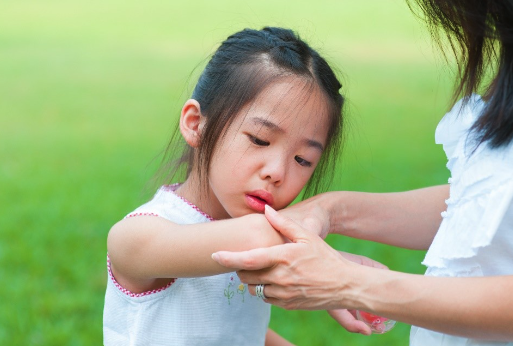
What is it?
Nursemaid’s elbow is a common injury in young children. Lifting the child up a step by the hand, giving the hand a sudden jerk, or pulling the child away from a dangerous situation can result in a subluxation or complete dislocation of one of the bones in the elbow. This condition is also known as pulled elbow or radial head dislocation. The term ‘nursemaid’s elbow’ dates back to when nursemaids or nannies were the common caregivers who would be minding the children and most commonly holding onto their hands.
How does this problem develop?
As mentioned, lifting the child up a step by the hand, giving the hand a sudden jerk, or pulling the child by the hand or forearm away from a dangerous situation can result in an elbow injury of this type. Playing with other children where one child swings the other around by the arms can also result in this injury.
What does nursemaid's elbow feel like?
Pain and an inability to straighten the elbow or supinate the forearm (turn the palm up) are typical. There is often tenderness along the lateral aspect of the elbow (side of the elbow away from the body). Bruising around the elbow several days after the injury is common.
How do healthcare professionals diagnose the problem?
These injuries commonly occur in children too young to actually tell a parent or healthcare provider what happened. In young children, crying and refusing to use the arm while holding it against the body are common behaviors associated with nursemaid's elbow.
Your physical therapist at Unified Therapy Services will ask questions about when the pain began, what your child was doing when the pain started, and what movements your child has avoided since the injury occurred.
If your physical therapist deducts from the history and physical examination that nursemaid’s elbow is the likely cause of your child’s pain, we will refer you to your doctor or emergency room for reduction of the joint back into place and possible x-rays.
Treatment
Often, if the reduction of the joint is uncomplicated, most children require no additional treatment and they are simply just encouraged to use the arm normally. If, however, your child continues to suffer from pain or lack of range of motion after the joint has been reduced (and a fracture has been ruled out) physical therapy is recommended.
Initially, the treatment we provide will be focused on relieving any pain your child has. In the clinic we may use modalities such as ice, heat, or taping and will educate you on the use of these modalities at home as well. Taping the elbow can assist in modifying the alignment of the joint and in doing so, decrease the pain your child feels when using the elbow or being active. We may also use other electrical modalities to help treat the pain if we feel it is necessary.
The next part of our treatment will focus on normalizing any deficits that may have developed in the range of motion and strength of your child’s elbow joint. Your physical therapist may assist in stretching your child’s elbow while in the clinic and, if necessary, will ‘mobilize’ the joint.
If your child is very young, your physical therapist may show you some simple games that you can play to encourage your child to improve range of motion with daily activity. If they are older, we may teach them a few specific but simple exercises that will again be encouraged throughout regular daily activity.
Similarly to the range of motion deficits, strength deficits will also be addressed. Again, your physical therapist at Unified Therapy will show you how to incorporate strengthening exercises into your child’s normal activities such as playing or eating.
The final part of treatment will be ensuring that your child’s coordination of the limb has returned to normal after the dislocation. Even a short period of abnormal joint use can cause the coordination and proprioception (the ability to know where your body is without looking at it) to decline in function. Exercises, such as weight bearing through the hand, ball tossing, and rotating the forearm will be encouraged throughout playing and everyday activities once your Physical Therapist determines these are safe activities to undertake.
After treatment
Fortunately, you will notice improvements in your child’s elbow function even after just a few treatments with us! If your child’s pain continues longer than it should or therapy is not progressing as your physical therapist would expect, we will ask you to follow-up with your child’s doctor to confirm that there are no complications that may be impeding your child’s recovery.
Maggie Liaboe, DPT, is a Physical Therapist with Unified Therapy Services. She provides care for pediatric patients and diagnoses and treats a variety of conditions.
For more information about our pediatric physical therapy clinic or to schedule an appointment, give us a call at 563-583-4003, option 1.
Sources: Maggie Liaboe, DPT, Unified Therapy Services, www.clevelandclinic.org, and www.kidshealth.org.
